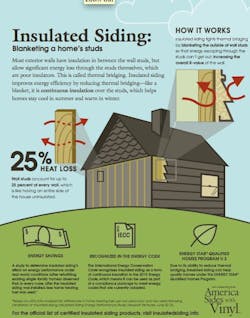The recent addition of insulated vinyl siding to a widely respected handbook of best engineering practices and its recognition as a means to comply with energy codes validates the product category as a material that can provide an insulation benefit to buildings, according to Jery Y. Huntley, president and CEO of the Vinyl Siding Institute (VSI).
Last week, Technical Committee 4.4 (TC 4.4) of ASHRAE, an international technical society for improving heating, ventilation, refrigeration, and air-conditioning, voted unanimously to add a reference to insulated vinyl siding within the table of Building and Insulating Materials in Chapter 26 of ASHRAE Handbook – Fundamentals. The Handbook is widely recognized as a major source of information on materials, energy calculation, and sustainability used by regulatory agencies, engineers, and architects.
In addition, in establishing the typical R-value range for insulated vinyl siding, TC 4.4 referenced the ASTM specification for insulated vinyl siding, ASTM D7793, which specifies a “field-like” R-value testing procedure based on the Federal Trade Commission-recognized method, ASTM C1363.
“With rigid foam insulation laminated or permanently attached to the panel, insulated siding is a proven product for helping to reduce energy loss through framing or other building material,” Huntley said. “We are pleased that such a distinguished organization is giving it formal recognition.”
The first field tests on insulated siding occurred in the early 1990s in the southern United States. In the years following, the product was developed through improvements in both the design and manufacturing processes to increase the product’s functionality and durability. The first commercial insulated siding was introduced in 1997.
Over the past decade, product developments have allowed insulated siding to experience consistent growth and recognition as home insulation. PR
Roofing & Siding
